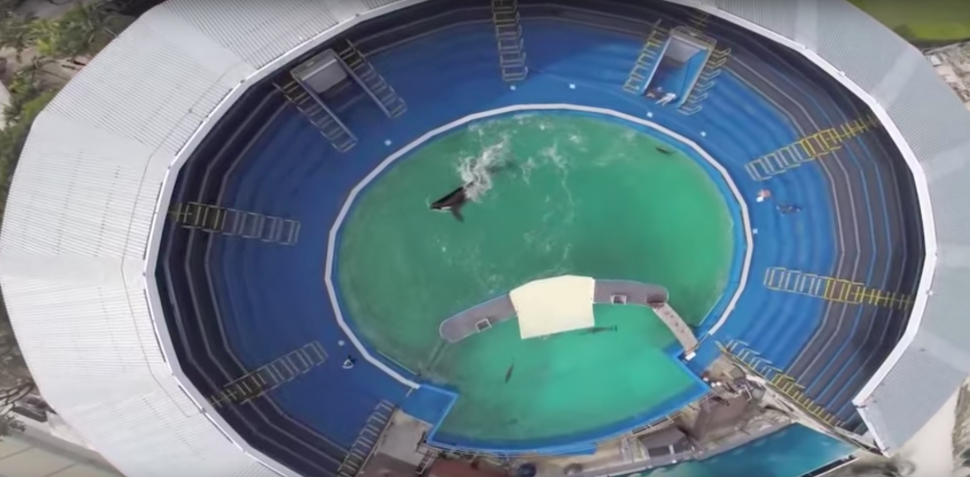
Days before Hurricane Irma descended on South Florida, inciting an evacuation of 5.6 million people, the Miami Seaquarium left many of their marine animals at the facility to ride out the storm, including their Orca whale, Lolita. The whale, surrounded by flimsy tin roof from the stadium surrounding her tank, along with several dolphins, were left in the tank uncovered. The aquarium is particularly vulnerable given their location on Virginia Key, a barrier island off the coast of Miami.
In contrast, dolphins at an aquarium in Cuba were airlifted to safety by helicopter out of Hurricane Irma’s path before it made landfall. In response to an inquiry on why they didn’t transport their animals to safety, The Miami Seaquarium said in a statement, “Miami Seaquarium has been at its present location since 1955 and it has withstood its fair share of storms. The park has an experienced and dedicated team working diligently to ensure our animals are safe. In preparation for the possible effects of Hurricane Irma, Miami Seaquarium has implemented its Hurricane Preparation Procedures. These protocols, which are constantly updated, clearly detail the necessary animal safety and precautionary measures to be implemented at the park. You can monitor our social channels for all updates regarding the park.”
Besides closing the park, the Miami Seaquarium provided no updates on their social media channels throughout the storm, nor did they explain what procedures were actually put in place to protect their animals during hurricanes, or clarify whether staff remained on site as Hurricane Irema approached. Reports from Miami have shown downtown Miami submerged by flooding.
“The threats to exposed captive killer whales include missile injuries, blunt force trauma, stress, and foreign objects in the pool, which can be swallowed. In nature the whales can ride out storms, spending their time predominantly below the surface and at greater depths,” said Dr. Jeffrey Ventre, a former SeaWorld trainer who advocates against Orca captivity. “The shallow
“In the case of Lolita, her stadium could literally collapse, and she’s alone. The Seaquarium was cited in 2003 for a ‘rusty roof beyond repair‘ as well as other issues,” He continued. “If she was lucky enough not to get hit or impaled by collapsing stadium elements, she stands the chance of being sliced by metal in her space. A second concern I have is that the expected storm surge, up to 10 feet, could undermine the structural elements of her tank including the perimeter glass that holds back the
Samantha Berg, another former SeaWorld trainer said in a September 10 post on the blog Voice of the Orcas, “Her tank is not deep enough for her to submerge and find refuge from flying debris. And, in an ironic turn of events, she even faces the potential of drowning if the surface of her tank becomes sufficiently blocked by falling detritus. Or maybe the filtration system will fail and she’ll have to spend days or weeks floating around in her own excrement. Her tank may over-heat if the power goes out and this could easily lead to a slower death from disease and injury.” She added the only proper way to prepare for a Hurricane of Irma’s magnitude was by getting the animals out of there.
Orca captivity and the facility’s treatment of Lolita has already been a controversial subject. The whale was captured in 1970 at the age of four. Documents released in 2016 noted the whale often suffers scrapes, and cuts from the dolphins that share her tank. She frequently needs antibiotics to treat these injuries. Environmentalists have been fighting through litigation to have Lolita freed and returned to the Pacific Northwest where she could live out the remainder of her life in a sea pen, but the Miami Seaquarium has pushed back on these efforts, claiming that Lolita has been taken care of in her tank, the smallest one for any orca in North America. The USDA released a report in June 2017 after auditing the aquarium. They found the tank likely does not meet the agency’s Animal Welfare regulations.
The 2013 documentary Blackfish exposed the harmful effects that captivity has on orcas—these animals regularly travel over 60 miles per day in the wild. In addition to health effects, psychological effects have been well documented. SeaWorld is currently under federal investigation for defrauding investors by misrepresenting their business downturn since the documentary’s release. In December 2017, PETA, the Animal Legal Defense Fund, and the Orca Nework will begin their oral argument before the U.S. Court of Appeals for the Eleventh Circuit to push for Lolita’s release under the endangered species act.

